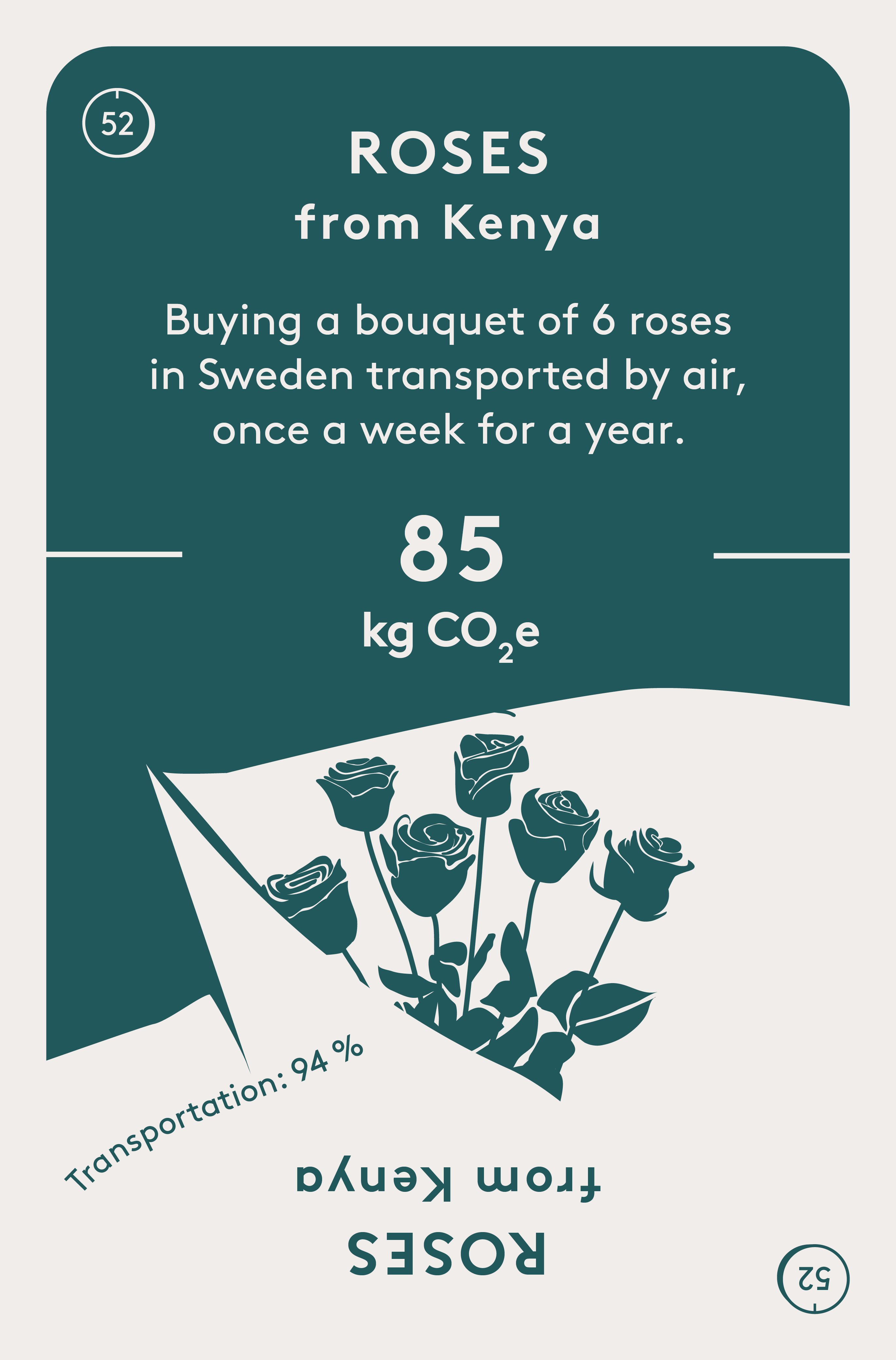ROSES
from Kenya

FOLLOW OUR CALCULATION
Click the expendable headlines to look at each step of the calculation.
Roses are cultivated on open fields in Kenya and transported to Europe by air. To calculate the greenhouse gas emissions, we have included emissions from both electricity consumption on the farm and transportation. The following data have been used to calculate emissions from electricity consumption during cultivation:
- Number of roses per bouquet: 6
- Weight per rose: 29 g (based on our own weighing of roses from Kenya)
- Electricity consumption on the farm: 0.16 MJ per rose (includes electricity for water pumps, irrigation systems, cold storage rooms, and lighting in office buildings on the farm; source: Bohm et al., 2013)
- Emissions from electricity: 121 g CO2e per MJ (global average electricity mix for the year 2022, source: Ember’s Yearly Electricity Data)
The electricity consumption for the cultivation of roses is calculated by multiplying the electricity consumption per rose by the number of roses per year. The calculation shows that it requires 50 MJ per year (0.16 MJ per rose × 6 roses per bouquet × 52 bouquets per year) to cultivate the roses.
The greenhouse gas emissions from electricity consumption are calculated by multiplying the total electricity consumption by the emission factor for electricity. The calculation shows that the emissions amount to 6 kg CO2e (50 MJ × 121 g CO2e per MJ). Emissions related to fuel consumption for machinery and the production of inputs used in cultivation, such as nitrogen fertilizers, are not included.
The roses are initially transported by a light truck from the farm in Kenya to the airport in Kenya. Following that, they are transported by aircraft from Kenya to Amsterdam. Lastly, the roses are transported by a heavy truck from Amsterdam to a flower shop in Stockholm. We differentiate between transportation by heavy and light truck since they have different energy efficiency. Both trucks are powered by diesel. The following data have been used to calculate emissions from transportation:
– Transportation distance by light truck: 100 km (from the farm in Kenya to the airport in Kenya)
– Transportation distance by air: 7 055 km (from the airport in Kenya to Amsterdam)
– Transportation distance heavy truck: 1 445 km (from Amsterdam to the flower shop in Stockholm)
– Energy consumption for transportation by light truck: 3.6 MJ per ton and km
– Energy consumption for transportation by aircraft: 7.7 MJ per ton and km
– Energy consumption for transportation by heavy truck: 1.8 MJ per ton and km
– Emissions from diesel combustion: 89 g CO2e per MJ
– Emissions from jet fuel combustion (kerosene): 88 g CO2e per MJ
– Amplification factor for increased climate impact due to emissions at high altitude: 70% (Lee m. fl., 2021)
The energy use for air transportation is calculated by multiplying the total weight of a year’s consumption of roses (9.05 kg) by the energy use for air transportation and the distance flown. The calculation shows that the energy use for air transportation amounts to 492 MJ (9.05 kg × 7.7 MJ per ton and km × 7 055 km). The corresponding calculation for the two truck transportation distances shows that the energy use amounts to 24 MJ for the heavy truck and 3 MJ for the light truck.
The greenhouse gas emissions from truck transportation are calculated by multiplying the energy use for truck transportation by the emission factor for diesel combustion. The calculation shows that truck transportation causes emissions of 2 kg CO2e (27 MJ × 89 g CO2e per MJ).
The greenhouse gas emissions from the consumption of aviation fuel are calculated by multiplying the energy use for air transportation by the emission factor for aviation fuel combustion. The climate impact caused by these emissions is referred to as the direct climate impact, as opposed to the indirect climate impact caused by emissions at high altitudes. The calculation shows that air transportation causes a direct climate impact of 43.3 kg CO2e (492 MJ × 88 g CO2e per MJ).
When emissions occur at high altitudes, the climate impact is enhanced compared to emissions at ground level. The extent of the climate impact amplification depends on the altitude where the emissions take place, which, in turn, is influenced by the distance traveled (the greater the distance, the higher the aircraft flies). In this case, the climate impact is enhanced by 70%. To include the high-altitude effect, the direct climate impact is multiplied by a factor of 1.7. This results in a total climate impact of 74 kg CO2e (43.3 kg CO2e × 1.7).
The total climate impact is calculated by adding the climate impact from electricity consumption on the farm to the climate impact from truck and air transportation. The calculation shows that the total climate impact amounts to 85 kg CO2e per year (9 + 2 + 74 kg CO2e).
See more card calculations: